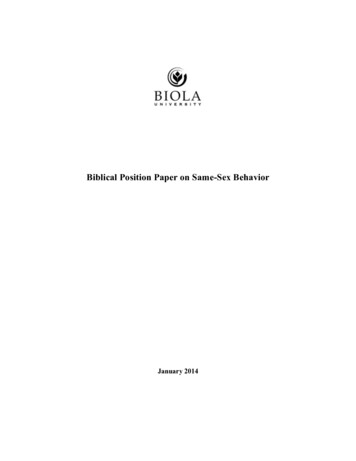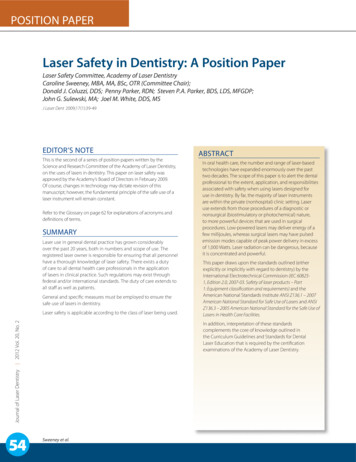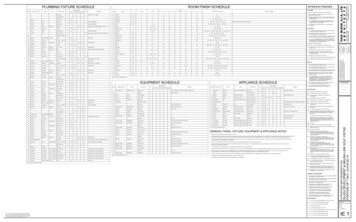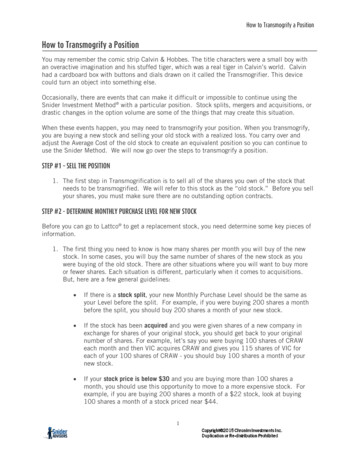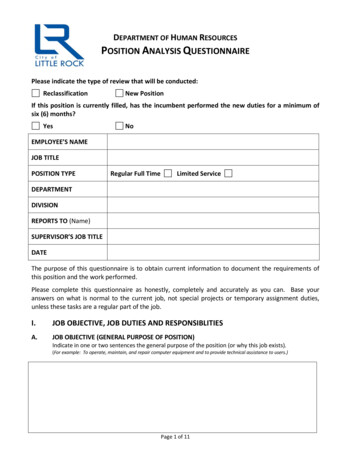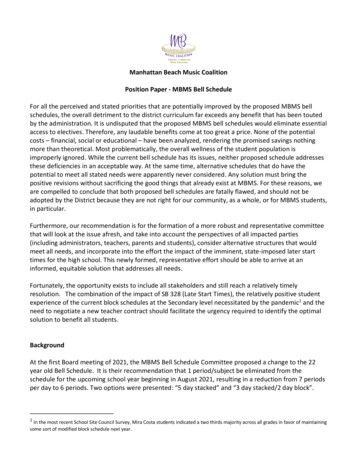
Transcription
Manhattan Beach Music CoalitionPosition Paper - MBMS Bell ScheduleFor all the perceived and stated priorities that are potentially improved by the proposed MBMS bellschedules, the overall detriment to the district curriculum far exceeds any benefit that has been toutedby the administration. It is undisputed that the proposed MBMS bell schedules would eliminate essentialaccess to electives. Therefore, any laudable benefits come at too great a price. None of the potentialcosts – financial, social or educational – have been analyzed, rendering the promised savings nothingmore than theoretical. Most problematically, the overall wellness of the student population isimproperly ignored. While the current bell schedule has its issues, neither proposed schedule addressesthese deficiencies in an acceptable way. At the same time, alternative schedules that do have thepotential to meet all stated needs were apparently never considered. Any solution must bring thepositive revisions without sacrificing the good things that already exist at MBMS. For these reasons, weare compelled to conclude that both proposed bell schedules are fatally flawed, and should not beadopted by the District because they are not right for our community, as a whole, or for MBMS students,in particular.Furthermore, our recommendation is for the formation of a more robust and representative committeethat will look at the issue afresh, and take into account the perspectives of all impacted parties(including administrators, teachers, parents and students), consider alternative structures that wouldmeet all needs, and incorporate into the effort the impact of the imminent, state-imposed later starttimes for the high school. This newly formed, representative effort should be able to arrive at aninformed, equitable solution that addresses all needs.Fortunately, the opportunity exists to include all stakeholders and still reach a relatively timelyresolution. The combination of the impact of SB 328 (Late Start Times), the relatively positive studentexperience of the current block schedules at the Secondary level necessitated by the pandemic1 and theneed to negotiate a new teacher contract should facilitate the urgency required to identify the optimalsolution to benefit all students.BackgroundAt the first Board meeting of 2021, the MBMS Bell Schedule Committee proposed a change to the 22year old Bell Schedule. It is their recommendation that 1 period/subject be eliminated from theschedule for the upcoming school year beginning in August 2021, resulting in a reduction from 7 periodsper day to 6 periods. Two options were presented: “5 day stacked” and “3 day stacked/2 day block”.1In the most recent School Site Council Survey, Mira Costa students indicated a two thirds majority across all grades in favor of maintainingsome sort of modified block schedule next year.
Ostensibly, the main reasons for this change were supposedly the need for increased provision for“Structured Enrichment & Remediation”; “Advisory Time” and “Increased Overall Instructional Time” aswell as “Teacher Collaboration”. These needs were presented as “Non-Negotiables”.2There are various definitions of what constitutes Overall Instructional Time. Generally speaking, actualclassroom instruction is any regularly scheduled classroom activity offered under the direct supervisionof a properly credentialed teacher employed by the District for the number of minutes established bythe District. In addition, activities like Homeroom may be considered instructional activity and countedas instructional time if the activity is under the immediate supervision of a properly credentialedteacher, and students are regularly assigned with their attendance recorded and reported as part of thedaily program schedule. However, passing time between classes and after breaks are also eligible tocounted as instructional time, as long as they aren’t excessive and must be equal between all classes foreach day of the week. Passing Periods of 5m are used in all the examples below. In fact, only Nutritionand Lunch periods are not considered instructional activity.Consequently, multiple categories of Instructional Time are used in this paper: Overall Instructional Time: Total time students spend in school excluding Nutrition and LunchPeriods. It also does not include Teacher Collaboration time as students are generally not atschool during those times.Overall Instructional Time (excluding Passing Periods): Same as above except for Passing PeriodsSubject-Specific Instructional Time: Instructional time spent on dedicated subjects so excludingHomeroom, Reading Time, Tutorial & Advisory periods.Non-Specific Instructional Time: Homeroom, Reading Time, Tutorial & Advisory periodsTraditional Bell ScheduleThe traditional MBMS Bell Schedule consists of a 7 period day with 44m per class for Periods 1-5 and45m for Periods 6-7. School begins at 8.10am with a 5m “Homeroom”, Passing Periods are 5m each,15m for Nutrition and 35m for Lunch. There is also a 15m Reading Period for each grade 4 days a week(excl. Wednesdays), facilitating staggered Lunch periods.2Bell Schedule Presentation to the Board of Trustees dated 1/13/21.MBMS Bell Schedule Position Paper - 2
On “Late Start Wednesdays”, the Start time is delayed 50m to 9am to allow for Teacher Collaborationand classes are shortened by 5m each to 39m for Periods 1-5 and to 40m for Periods 6-7 as aconsequence. Everything else is the same except for the absence of both the 15m Reading Period andZero Period.That yields a total weekly time of 2,050m (excluding Zero Period), utilized as follows: 1,750m Overall Instructional Time1,600m Overall Instructional Time (excluding Passing Periods)MBMS Bell Schedule Position Paper - 3
1,515m Subject-Specific Instructional Time (216m per subject/week)60m Reading Time25m Homeroom50m Teacher Collaboration150m Passing Time (6 Passing Periods per day)75m Nutrition175m LunchProposed Bell SchedulesThe first proposed schedule has room for just 6 subjects spread over 6 periods per day for five days.This breaks down as follows: A start time of 8:05am (vs. 8:10am); an average 48m per class/period (45mper class/period on M/W; 50m on Th/Th/F); Passing Periods of 5m; only 10m for Nutrition (vs. 15m) and35m for Lunch; 65m twice a week for Teacher Collaboration so presumably school ends early at 1:45pmfor Students on those days too; Tutorial Time of 40m twice a week; 40m for Advisory once a week (whilethe Presentation only claims 35m for Advisory, both Lunch 7/8 and Advisory 6 are actually scheduled for40m even though they are marked as 35m. So there is room for a 40m Advisory period). In addition,Zero Period is expanded by 30m/week (5 x 50m vs. 4 x 55m).That yields a total weekly time of 2,075m (excluding Zero Period), utilized as follows: 1,700m Overall Instructional Time1,560m Overall Instructional Time (excluding Passing Periods)1,440m Subject-Specific Instructional Time (240m per subject/week)80m Tutorial Time40m Advisory130m Teacher CollaborationMBMS Bell Schedule Position Paper - 4
140m Passing Time (6 Passing Periods/3 days; 5 Passing Periods/2 days)20m Non-Instructional Passing time (last bell at 1.45pm/2 days but Collaboration doesn’t startuntil 1.55pm)50m Nutrition175m LunchAn alternative option is for a 3 period block on two days instead.This reduces the number of Passing Periods from 6 to 3 on those two days, saving 15m/day. Thesesavings are distributed as follows: Nutrition is expanded to 15m (from 10m) and Tutorial to 45m (from40m). Additionally, the first block period is expanded to 105m (from 100m). Zero Period is alsoexpanded by 30m/week (5 x 50m vs. 4 x 55m).That yields a total weekly time of 2,075m (excluding Zero Period), utilized as follows: 1,690m Overall Instructional Time1,580m Overall Instructional Time (excluding Passing Periods)1,450m Subject-Specific Instructional Time (242m per subject/week)90m Tutorial Time35m Advisory130m Teacher Collaboration110m Passing Time (6 Passing Periods/1 day; 5 Passing Periods/2 days; 3 Passing Periods/2 days)20m Non-Instructional Passing time (last bell at 1.45pm/2 days but Collaboration doesn’t startuntil 1.55pm)65m Nutrition175m LunchOverall, the comparison between the current and proposed schedules is as follows:MBMS Bell Schedule Position Paper - 5
While the proposed move to 6 periods does provide an additional 30-40m of Non-Specific InstructionalTime (SEL/Intervention), over half comes from reducing Nutrition by 15-25m and the rest fromlengthening the school day by 25m per week. Increasing Teacher Collaboration time by 80m comesprimarily from reducing Overall Instructional Time by 50-60m.Furthermore, students are losing an elective in 7th & 8th grade (in addition to a reduced 6th GradeHumanities block). Electives are normally a huge source of SEL. Consequently, it’s reasonable to statethat there is actually a net loss of SEL time as each lost elective represents 215m/week of SEL time. Theimpact on SEL of losing an elective in both 7th & 8th grades will be addressed in more detail below.Alternative SchedulesAre there alternative schedules that would meet the stated goals but without the collateral damage tothe electives and World Language departments? Other middle schools use modified block schedules toprovide their students access to 7 subjects while also providing dedicated Intervention/SEL time. Here isan example:MBMS Bell Schedule Position Paper - 6
That yields a total weekly time of 2,075m, utilized as follows: 1,750m Overall Instructional Time1,635m Overall Instructional Time (excluding Passing Periods)1,500m Subject-Specific Instructional Time (214m per subject/week)90m Tutorial Time45m Advisory100m Teacher Collaboration115m Passing Time (4 Passing Periods/2 day; 5 Passing Periods/3 days)50m Nutrition175m LunchAs you can see, this example of a 7 Subject Rolling Block meets all the needs that were presented as“Non-Negotiables”.It provides almost all the benefits of the proposed 6 Period schedules without sacrificing any electives orWorld Language options. In addition, every subject averages “touch” 4 times every week, including adouble block once every 7 school days. Furthermore, research has shown that students perform betterin some courses at different times of the day and rotation allows all students to access courses at theirpeak learning time. Another benefit is that student absences for illness, field trips or recurring sportsparticipation are less impactful on a single class/subject.MBMS Bell Schedule Position Paper - 7
Students and parents may need tools, however, to keep track of the rotation they are on, and what classoccurs first on any given day.Alternatively, it’s possible to maintain 7 periods for 3 days/week and have a 4 period block schedule onthe other two days while achieving all the stated goals or “non-negotiables”, in some ways even betterthan the proposed 6 Period schedules.That yields a total weekly time of 2,075m, utilized as follows: 1,750m Overall Instructional Time1,625m Overall Instructional Time (excluding Passing Periods)1,523m Subject-Specific Instructional Time (218m per subject/week)77m Tutorial Time25m Advisory100m Teacher Collaboration125m Passing Time (4 Passing Periods/2 day; 5 Passing Periods/3 days)50m Nutrition175m LunchThis schedule has the added advantage of providing students with two late starts a week, somethingthat would further enhance SEL through providing opportunities for more sleep, which is welldocumented to have one of the larger, if not the largest, positive impacts on SEL.33As a result of SB 328, the high school will be forced to move to a late start of 8.30am by August 2022 at the latest. This would inevitablymean a later end time of around 3.30pm. It would seem to make sense that the middle school would seek to align start and end times, atthe very least, to facilitate student drop-off and pick-up times across campuses that are barely a 5-10m drive (or 1.3 miles) apart, even if SB328 does not mandate a start time of later than 8am for middle schools.MBMS Bell Schedule Position Paper - 8
Regarding the impact on Zero Period of these late starts, it is not clear what the requirements areregarding minutes, schedules etc. Feasibly, Zero Period could occur during one or both of the earlymorning Teacher Collaboration times. Alternatively, one or both of the Collaboration periods could alsobe switched to the afternoon, allowing for early student departures on those days and providing for aregular Zero Period schedule.In addition, consideration should be given to an after-school Period 8 (instead of or in addition to ZeroPeriod), as happens at Adams Middle School in Redondo Beach, one of the schools that the BellSchedule committee supposedly visited. This would also have the benefit of better aligning with theimminent later end times at the high school.So why weren’t some schedules like these considered? Or the many other examples from middleschools around the country?Student/Teacher LoadThe current average student/teacher load at MBMS is 204 students/teacher which appears onerous andis probably untenable over the long run. The conventional method for reducing student/teacher load isto reduce average class sizes by the hiring of more teachers. To get to the target student/teacher loadof 170, while maintaining the current bell schedule, would involve lowering the average class from thecurrent 34 to 28.MBMS Bell Schedule Position Paper - 9
MBMS student enrollment has been steady at 1,440 for the two years preceding the pandemic. Thisyear it is down 100 students. Consequently, making the assumption that all 1,440 students aregenerally in class during any particular period, that results in 42 teachers, each with classes of 34students. Decreasing class size to 28 requires 52 teachers with classes of 28 students. Given thecaveats that teachers don’t teach every period, not every student would need to be in these classes, andenrollment may still be down next year, a reasonable assumption is that there would be a need to hireabout 7-8 new teachers that are qualified to teach the main academic classes of English, Math, Scienceand Social Studies, costing 700-800,000 annually.4 Additionally, 7-8 new classrooms would beneeded to house them, unless teachers are willing to share classrooms in some way. It’s not clearwhether there are enough surplus classrooms at MBMS. However, 2-3 classrooms will likely open uponce the new Music Rehearsal Building is completed in the summer of 2022.An alternative method to lower student/teacher load is to reduce the numbers of classes taught perteacher. Changing from 7 to 6 periods means that the average teacher would lower the number ofclasses taught from 6 to 5 (given that teachers are allowed one preparation period per day), reducingthe student/teacher load by 1/6th from the current high of 204 students/teacher to 170 while stillmaintaining average classes sizes of 34.Hence the proposal to reduce to 6 periods (and subjects - we shouldn’t conflate the two), eliminating anelective and compressing the World Language curriculum into one class/year during 8th Grade. Togetherwith reducing 6th Grade Humanities to 2 periods and having those teachers cover 1-2 Social Studiesand/or English classes (assuming that they have the requisite qualifications), this would likely save 4-5FTE (and classrooms!) which yields the current estimate, per the Superintendent, of a net 2-4 new FTErequired, at a cost of 200-400,000 annually.It’s apparent that this is a huge driver (probably the pre-eminent one) for this proposed change to a 6period day. Basically, the loss of an elective will reduce the demand for Electives and/or WorldLanguages classes/teachers and those savings are being used to subsidize the hiring of new English,Math, Science & Social Studies teachers.All the extra Advisory/Tutorial/Teacher Collaboration is worthy but is not driving this train. As notedabove, one could design either a 7 subject schedule with a maximum of 5-6 periods per day or even a 7period schedule, with extra Tutorial/Advisory/Collaboration periods, using a modified block schedule,4The actual cost of implementing either proposed bell schedule received an unaccountably sparse amount of airtime during thepresentation. When asked this question directly by a Board Member, Dr. Matthews quoted a need for 2-4 additional FTE. He alsospeculated that the cost could be “ 200,000 to 400,000 annually” (in line with the estimate of 100,000 per FTE) (cf. Bell SchedulePresentation to the Board of Trustees, dated 1/13/21 at timestamp 47:07-48:20). This was the extent of the cost “analysis” offered on thisfundamental question. Nor has a considered examination of the logistics involved taken place. So we are operating in a vacuum, and at riskof filling in gaping holes with imperfect assumptions. How, exactly, the proposed 6 subject day would play out across all classes and allgrade levels is not known and was not described during the Board Meeting or in the attached Presentation. What, exactly, the cost wouldbe of either plan as compared to preserving a 7 period day, with accommodations to account for needs such as teacher collaboration, wasentirely absent. The comparative cost of using other block schedules that include 7 subjects as well as advisory and collaboration periods as best as can be gleaned - was apparently never considered from the outset.MBMS Bell Schedule Position Paper - 10
and having touch in all subjects 4 times a week without cutting overall instructional time, that is likelyacceptable to every department. Other schools already do this.But it wouldn’t reduce student/teacher load or class sizes as you still have some 1,440 students with, onaverage, the same number of academic teachers, yielding the same load. The only options to reduceload is to have fewer subjects (not periods), smaller class sizes or some combination of the two. Bothoptions cost the exact same amount of money in terms of new hires (estimated at 7-8 FTE or 700800,000 annually) if the target load is 170 in both cases. The only difference is that the 6 subject day willhelp subsidize the cost of new teachers by using layoffs/reallocations to reduce the NET number of newteachers needed to only 2-4 FTE (or 200-400,000 annually), assuming the estimate given during theBoard discussion is correct.It should be noted that lowering student/teacher load by reducing average class sizes to 28 whilemaintaining 7 subjects is of far greater benefit to students and teachers on so many levels than is thealternative option of decreasing the number of subjects to just 6 subjects, but maintaining class sizes at34. And the lowering of average class sizes (and, thus, student/teacher loads) can be phased in overseveral years as the new teachers are added in smaller, more financially sustainable increments.Potential Impact of 7 Subjects vs. 6 Subjects on SEL at MBMSWhat are the consequences of eliminating an elective in both 7 & 8th grade and compressing the WorldLanguage curriculum into one year in 8th Grade rather than spreading it over 2 years in 7th & 8th Grade?One of the most prominent points raised in the Bell Schedule Presentation was that the proposedschedule was needed to accommodate “new” requirements for Social and Emotional Learning (SEL), andthat the proposed bell schedules were mandated in order for the District to comply with new SELrequirements. There were several moments during the presentation that suggested, or boldly claimed,that choosing one of these proposed bell schedules was in fact mandated by new laws imposing such arequirement. For example, one slide had “State Mandate” directly paired with “Social EmotionalLearning.”5 One Presenter stated, “we have a social, emotional learning component that is now a statemandated component to our school schedule.”6 And next to a slide that stated “Advisory (SocialEmotio
Traditional Bell Schedule The traditional MBMS Bell Schedule consists of a 7 period day with 44m per class for Periods 1-5 and 45m for Periods 6-7. School begins at 8.10am with a 5m “Homeroom”, Passing Periods are 5m each, 15m for Nutrition and 35m for Lunch. There


